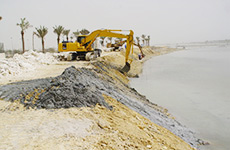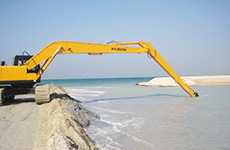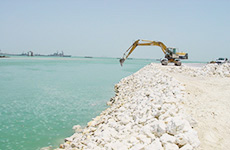


Coastal Protection
There are several strategies for costal defense but the most common ones used in the kingdom are the following
Offshore breakwater
Enormous concrete blocks and natural boulders are sunk offshore to alter wave direction and to filter the energy of waves and tides. The waves break further offshore and therefore reduce their erosive power. This leads to wider beaches, which absorb the reduced wave energy, protecting cliff and settlements behind.
Beach Replenishment
Beach replenishment or nourishment is one of the most popular soft engineering techniques of coastal defense management schemes. This involves importing sand off the beach and piling it on top of the existing sand. The imported sand must be of a similar quality to the existing beach material so it can integrate with the natural processes occurring there, without causing any adverse effects.
Sea walls
Walls of concrete or rock, built at the base of a cliff or at the back of a beach, are used to protect a settlement against erosion or flooding. They are usually about 3–5 metres (10–16 ft) high. Older-style vertical seawalls reflected all the energy of the waves back out to sea, and for this purpose were often given recurved crest walls which also increase the local turbulence, and thus increasing entrainment of sand and sediment. During storms, sea walls help longshore drift.
We are proud to be one of the leading companies in this filed being involved in various government and private sector projects for coastal protection. Over the years we had carried out a significant amount of projects to protect and beautify Bahrain seacoast.
